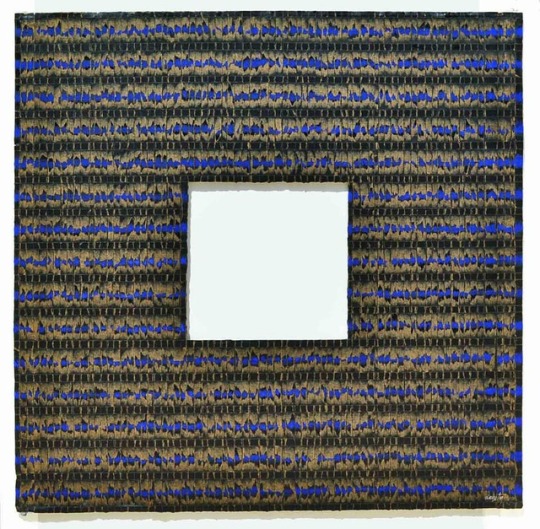#pierre daquin
Explore tagged Tumblr posts
Text
Mars MMXXV
Films
Le Dernier Samouraï (The Last Samurai) de Edward Zwick avec Tom Cruise, Ken Watanabe, Hiroyuki Sanada, Koyuki Katō, Masato Harada, Shichinosuke Nakamura et Timothy Spall
Impossible… pas français (1974) de et avec Robert Lamoureux et aussi Pierre Mondy, Jean Lefebvre, Pierre Tornade, Claire Maurier, Hubert Godon, France Dougnac, Michel Creton, Raphaël Delpard, Jacques Marin, Yves Vincent et Alix Mahieux
Vixen! (1968) de Russ Meyer avec Erica Gavin, Garth Pillsbury, Harrison Page, Jon Evans, Vincene Wallace, Robert Aiken et Michael Donovan O'Donnell
C'était un rendez-vous (1976) de et avec Claude Lelouch et aussi Gunilla Friden
Psych 2: Lassie Come Home (2020) de Steve Franks avec James Roday, Dulé Hill, Timothy Omundson, Maggie Lawson, Kirsten Nelson, Corbin Bernsen, Joel McHale, Kurt Fuller, Jazmyn Simon : Selene et Sarah Chalke
Mon oncle d'Amérique (1980) d'Alain Resnais avec Roger Pierre, Nicole Garcia, Gérard Depardieu, Pierre Arditi, Gérard Darrieu, Philippe Laudenbach, Marie Dubois, Henri Laborit, Nelly Borgeaud, Bernard Malaterre et Laurence Roy
La Légende de Bagger Vance (The Legend of Bagger Vance) (2000) de Robert Redford avec Will Smith, Matt Damon, Charlize Theron, Bruce McGill, Joel Gretsch, J. Michael Moncrief, Peter Gerety, Michael O'Neill et Jack Lemmon
La Scoumoune (1972) de José Giovanni avec Jean-Paul Belmondo, Claudia Cardinale, Michel Constantin, Philippe Brizard, Enrique Lucero, Michel Peyrelon, Alain Mottet, Jacques Debary, Jean-Claude Michel et Marc Eyraud
Miss Potter (2006) de Chris Noonan avec Renée Zellweger, Ewan McGregor, Emily Watson, Barbara Flynn, Bill Paterson, Matyelok Gibbs, Lloyd Owen, Anton Lesser, David Bamber, Patricia Kerrigan et Judith Barker
Mince alors ! (2012) de et avec Charlotte de Turckheim et aussi Lola Dewaere, Grégory Fitoussi, Victoria Abril, Catherine Hosmalin, Émilie Gavois-Kahn, Barbara Bolotner, Dominique Besnehard, Alain Stern, Martin Daquin et Valérie Moreau
Motor Psycho (1965) de Russ Meyer avec Stephen Oliver, Timothy Scott, Joseph Cellini, Alex Rocco, Holle K. Winters, Coleman Francis, Haji et Sharon Lee
Olympe, une femme dans la Révolution (2025) de Mathieu Busson et de et avec Julie Gayet avec aussi Dimitri Storoge, Pauline Serieys, Jean-Pierre Lorit, Pablo Cobo, Lucas Ferraton, Amandine Dewasmes, Émilie Gavois-Kahn et Benjamin Guillaume
The Brasher Doubloon (1947) de John Brahm avec George Montgomery, Nancy Guild, Conrad Janis, Roy Roberts, Fritz Kortner, Florence Bates et Marvin Miller
Masques (1987) de Claude Chabrol avec Philippe Noiret, Robin Renucci, Anne Brochet, Monique Chaumette, Pierre-François Duméniaud, Bernadette Lafont, Roger Dumas, Pierre Nougaro et Renée Dennsy
Joyeuses Funérailles (Death at a Funeral) (2007) de Frank Oz avec Matthew Macfadyen, Keeley Hawes, Andy Nyman, Ewen Bremner, Daisy Donovan, Alan Tudyk, Jane Asher, Kris Marshall, Rupert Graves, Peter Vaughan, Peter Egan et Peter Dinklage
Anaconda (2005) de Benjamin Geffroy avec Alexandre Astier
La Rose pourpre du Caire (The Purple Rose of Cairo) (1985) de Woody Allen avec Mia Farrow, Jeff Daniels, Danny Aiello, Irving Metzman, Stephanie Farrow, David Kieserman, Edward Herrmann, John Wood et Deborah Rush
Séries
Bref.2 Saison 2
Bref. Tout redémarre. - Bref. C'était trop tard. - Bref. C'est une question de point de vue. - Bref. Tout va bien. - Bref. C'était sous mes yeux depuis le début. - Bref. C'est du sérieux ?
Kaamelott Livre II, III
Aux Yeux de Tous - Immaculé Karadoc - La Morsure du Dace - Les Neiges Eternelles - Des Hommes d'Honneur - Stargate - Feue la Vache de Roparzh - Les Vœux - Le Pédagogue - Perceval et le Contre-Sirop - L'Oubli - L'Ambition - Le Poème - Corpore Sano - Le Havre de Paix - L'Anniversaire de Guenièvre - La Botte Secrète II - Les Parchemins Magiques - L'Enragé - Trois Cent Soixante Degrés - Pupi - Vox Populi II - Le Rebelle - Les Félicitations - Les Paris - Les Esclaves - Les Drapeaux - Le Guet - Le Sort Perdu - La Restriction - La Corde - Le Tourment II - Le Plat National - Le Temps des Secrets - La Conscience d'Arthur - La Frange Romaine - L'Orateur - Les Comptes - Le Chevalier errant - L’Aveu de Bohort - Le Magnanime - Le Porte-bonheur - Séfriane d’Aquitaine - Le Combat des chefs - Le Déserteur - La Potion de vivacité - Le Sanglier de Cornouailles - L’Ankou - Ablutions - La Poétique : première partie - La Poétique : deuxième partie - Les Derniers Outrages - Guenièvre et Euripide - Unagi III - Le Fléau de Dieu II - Cryda de Tintagel - L’Ivresse II - Legenda - Le Renfort magique - Silbury Hill II - Le Professionnel - Les Suppléants - La Nuit du nomade - L’Assemblée des rois : première partie - L’Assemblée des rois : deuxième partie - L’Arche de transport - Les Cousins - Le Trouble - Le Tournoi - La Pierre de Lune - La Pythie - Les Cheveux noirs - Dream On - Feue la poule de Guethenoc - Le Repos du guerrier II - Les Affranchis - Les Clous de la Sainte Croix - La Corne d’abondance - Morituri - Le Dialogue de paix II - Stargate II - L’Abstinent - Aux yeux de tous II - La Potion de vérité - Le Petit Poucet - Haunted II - La Révolte II - Perceval chante Sloubi - Le Jour d’Alexandre - La Cassette II - Poltergeist - Les Paris II - Au Bonheur des Dames - Les Tourelles
Columbo Saison 7, 1, 2, 4
Meurtre parfait - Une ville fatale - Dites-le avec des fleurs - Symphonie en noir - Eaux troubles - État d'esprit
K2000 Saison 2, 3
Souvenirs perdus - Les bohémiens - Le trésor de Charlie - Une agence très spéciale - Une nuit pour les étoiles - Course pour la vie - La victoire à tout prix - Le retour de Goliath : première partie - Le retour de Goliath : deuxième partie - Mini puce - La bouche du serpent : première partie - La bouche du serpent : deuxième partie - Ma plus belle chanson d'amour - Travaux publics - Le roi des robots - : première partie - Le roi des robots : deuxième partie - Les voleurs de diamants - Toujours plus vite - Bal costumé - Le retour de K.A.R.R. - Les bâtards
Friends Saison 9
Celui qui n'avait demandé personne en mariage - Celui qui acceptait sa mutation - Celui qui allait chez le pédiatre - Celui qui regardait des requins - Celui qui avait fumé - Celui qui était le plus drôle - Celui qui faisait rire sa fille - Celui qui était vexé - Celui qui n'osait pas dire la vérité - Celui qui passait Noël à Tulsa - Celui qui ne voulait plus de bébé - Celui qui défendait sa nounou - Celui qui se faisait épiler - Celui qui se faisait agresser - Celui qui se faisait poser un lapin - Celui qui prêtait de l'argent
Astrid et Raphaëlle Saison 5
On ne meurt qu'une seule fois - Mais c'est pour si longtemps - Mandala - Le dernier des Aztèques - Le baptême des morts - Loup y es-tu ? - On achève bien les jockeys - Un mariage et quatre enterrements
Les Cinq Dernières Minutes Saison 1
La Rose de fer - Un mort à la une - Mort d'un casseur - Fenêtre sur jardin
Douglas is Cancelled
Episode 1 - Episode 2 - Episode 3 - Episode 4
Alexandra Ehle Saison 5
Feu sacré - L'effet miroir
Hudson et Rex Saison 6
Le Bateau fantôme - Dernière bataille - Les Murs ont des oreilles - Assurance tous risques - Le Gardien de la nuit - Le Meilleur ami de l'homme - Ballet d'espions
WWE Biographies Saison 2
Undertaker - Edge
Spectacles
Alchemy Live : Dire Straits (1983) au Hammersmith Apollo, Londres
James Taylor : One Man Band (2007)
Diana Krall : Doing All Right (2008)
La Facture (1976) de Françoise Dorin avec Jacqueline Maillan, Viviane Gosset, Jean Barney, Julien Bertheau, Denise Provence, Jacques Ramade et Yves Massard
Roberto Fonseca : Live in Marciac (2009)
Toto : 25th Anniversary: Live in Amsterdam (2003)
Livres
L'attaque des dauphins tueurs de Julien Campredon
OSS 117 préfère les rousses de Jean Bruce
Lucky Luke, tome 31 : Les Dalton à la noce de Morris, Xavier Fauche et Jean Léturgie
Hero Corp, tome 1 : Les origines de Simon Astier et Marco Failla
Détective Conan, tome 27 de Gosho Aoyama
Détective Conan, tome 28 de Gosho Aoyama
Détective Conan, tome 29 de Gosho Aoyama
0 notes
Text
ON VEUT TUER MA SOEUR ANNE
Rue de Sébastopol
Arila Daquin
La flamme olympique
Pas Action Française
Pas Pierre de Courbertin
Mai le rite Républicain
Jeudi 4 juillet 2024
0 notes
Photo

(Artist Pierre Daquin's tapestry "La Vue" courtesy of Galerie Chevalier as part of The 13th Floor project)
Several art fairs took over Los Angeles last weekend, two of which used hotels to create temporary galleries and installations.
At the The Hollywood Roosevelt was the first edition of Felix, a free art fair co-founded by Dean Valentine along with brothers Al Morán and Mills Morán (of LA gallery Morán Morán). Galleries took over rooms along the pool, on the 11th floor, and the penthouse. Starting at the penthouse was The 13th Floor (pictured above), a collection of work by French artists curated by writer Andrew Berardini and presented by The French Committee of Art Galleries and the Cultural Services of the French embassy.

Kenny Schachter had some fun pieces in his room on the 11th Floor including Ilona Rich's sculptures, one of which was in the bathroom shower (pictured above), and a framed collection of artist Chris Burden's cancelled checks.
Bodega gallery, from New York's Lower East Side, had a selection of interesting work including paintings by Alexandra Noel (pictured below).

Grice Bench's selections included a collection of lovely watercolors by Roger White and a painting placed above the bed by Lara Schnitger (pictured below).
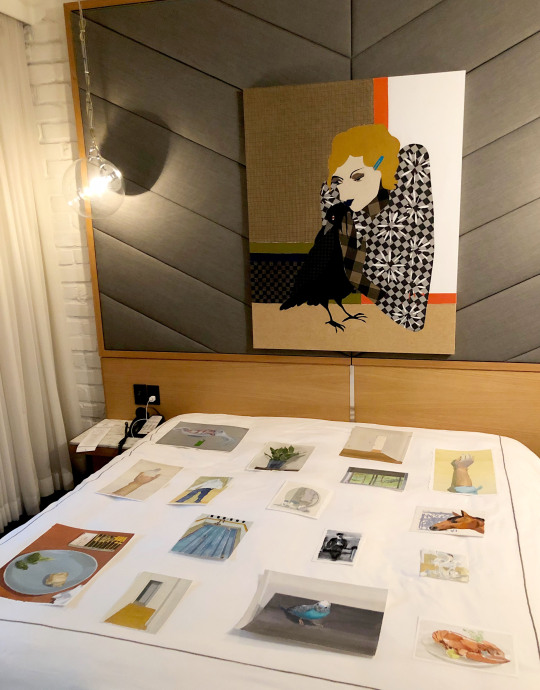
On the ground floor Marc Selwyn Fine Art presented Jennifer Aniston's Used Book Sale, artist Kristen Morgin's incredibly realistic ceramic replicas of books she imagines might make up the actress' collection (the VHS tape is real).

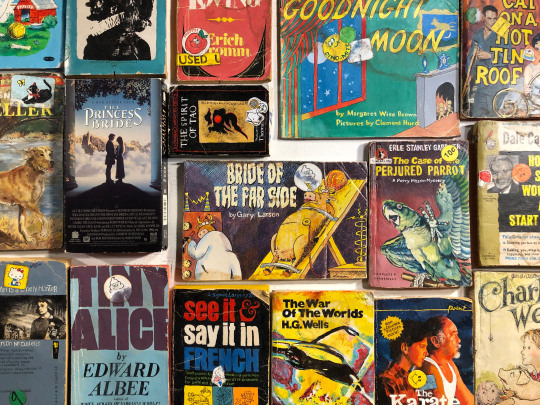
At a hotel in a completely different part of town was the stARTup Art Fair, taking place at The Kinney in Venice. Here, instead of galleries representing the artists, it's the artists that set up their rooms and sell their art. It made for a great experience as the artists were all very friendly and eager to discuss their work. Below are a few highlights from the fair.

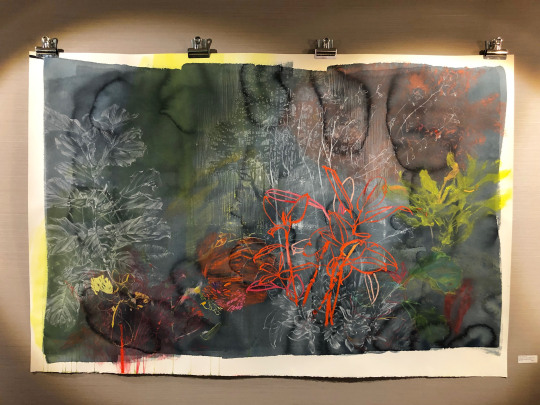
San Francisco artists Lisa Kairos and Melissa Mohammadi's room was filled with really beautiful work. Kairos makes dreamy multilayered paintings based on natural landscapes. She then cuts patterns into the images which adds yet another dimension to the paintings. Mohammadi's work incorporates botanical and marine life into a meditative world where bright pastels stand out among subdued watercolor backgrounds; highly detailed sections mix with the more abstract. The end result for both artists is work you want to spend time looking at.
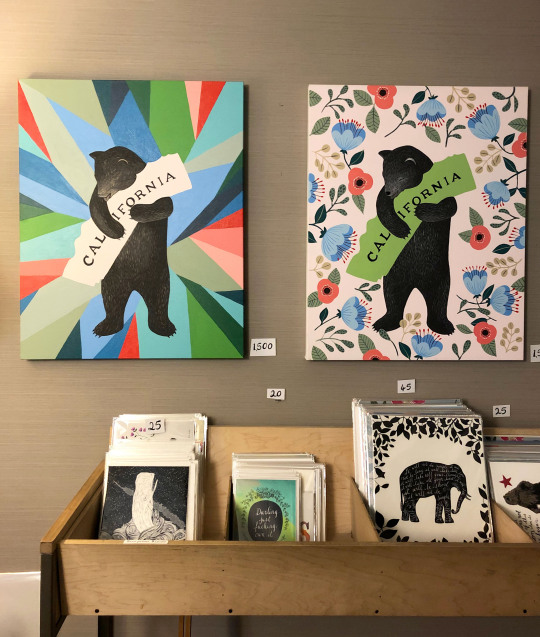
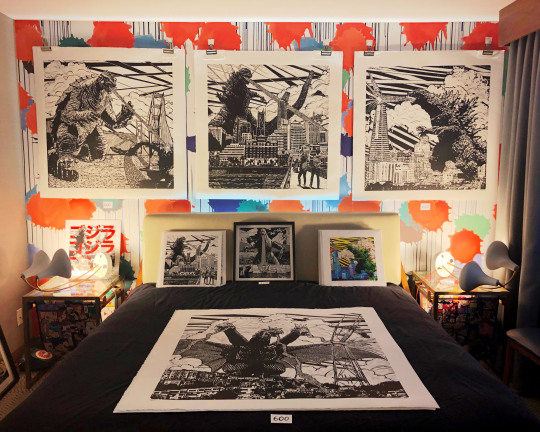
Husband and wife artists Eric Rewitzer and Annie Galvin of 3 Fish Studios in San Francisco had lots of great, affordable prints. They also teach printmaking and collage classes in their studio.

youtube
Artist Camila Magrane had several pieces in her darkened hotel room that use augmented reality technology to make the works animated and three dimensional when looked at through her Virtual Mutations app. The video above illustrates the effect.

Jeff Horton uses his architecture background to create paintings of urban structures (often larger than what's pictured above), some of which incorporate wax with oil paint for an added layer.
Other artists work not shown but worth checking out- Los Angeles based Margaret Hyde makes ethereal still life photographs of natural objects she finds and combines with water, and Kyong Ae Kim showed a variety of impressive work including her animal skulls cut from multiple layers of drafting film and acrylic paintings combined with hand cut elements.
#felix art fair#stARTup art fair#pierre daquin#galerie chevalier#kenny schachter#bodega gallery#alexandra noel#roger white#lara schnitger#grice bench#marc selwyn#kristen morgin#lisa kairos#melissa mohammadi#3 fish studios#camila magrane#eric rewitzer#annie galvin#jeff horton#margaret hyde#kyong ae kim#los angeles art shows#los angeles art fairs#los angeles#art#painting#photography#sculpture#weaving
0 notes
Video
youtube
Angèle - Balance Ton Quoi [CLIP OFFICIEL] via https://www.youtube.com/watch?v=Hi7Rx3En7-k // "Brol la suite", inclus 7 titres inédits, écoutez-les maintenant : https://lnk.to/BrolLaSuiteYD Instagram : http://www.instagram.com/angele_vl Facebook : http://www.facebook.com/angeleouenpoudre Angèle en concert : https://lnk.to/AngeleConcertsYD Brol Shop : https://lnk.to/AngeleShopYD Écouter tous les titres d'Angèle : https://lnk.to/AngeleDigitalYD -- Réalisation : Charlotte Abramow Scénario : Charlotte Abramow, Ophélie Secq & Angèle Scène de comédie co-écrite par Charlotte Abramow, Ophélie Secq, Angèle & Pierre Niney Avec la participation de Pierre Niney & Antoine Gouy Production : Big Productions (Arthur Catton & Nizar El Tayeb) Directeur de production : Jean-Claude Marx 1ère Assistante réal. : Marie Le Grévellec 2ème Assistante réal. : Charlyne Liquito DOP : Quentin de Lamarzelle 1er Assistant caméra : Arslan Terrien 2e Assistant caméra : Charles Dalodier Data Manager : Louise Autain Steadycam : Ben Groussain Chef Electro : Basile Barniské Electros : Yann Ody, Raphaël Jamot & Vincent Taberlet Chef Machino : Bruno Martin Machinos : William Herrero & Marie-Anouke Chef Deco : Lucie Beauvert 1er Assistant déco : Emmanuel Le Cerf 2ème Assistante déco : Sarah Illitch-Weldon Ripper/Constructeur : Samuel Cochon Stylisme : Alizée Hénot Assistantes stylisme : Elyse Arnout & Florine Da Silva Costumière juge & avocat : Marion Brioullet Uniformes Anti-Sexism Academy : Meuf Paris Costumière seins : Noémie Veissier Make-up : Ophélie Secq Make-up SFX : Alexandra Petry Superviseur SFX: Davide Mendes & Patrick Bennar Assistants make-up : Joanna Faivre, Marie Guillon, Chloé Desmoussis & Alice Cottet Hair : Rimi Ura Assistants hair : Melissa Gaboriau, Ryoya Murakoshi, Marta Tayanoushkaya & Gwen Diakite Illustrations : Cécile Dormeau Ingénieur du son : Mathieu Leroy Perchman : Maxime Dufils Régie : Simon Lech’vien, Kévin Chamaplaune, Vincent Decremps, Canelle Begoug & Tom Marchal Casting : Casting by Charlotte & HO Studio Directrice de post-production : Natacha Dolard Montage : Zoé Sassier Étalonnage : Rémy de Vlieger Mixage sonore : Le comptoir du son Post-production : MIKROS (supervisé par Patrick Bennar) Merci à : Pierre Niney, Nikita Bellucci, Antoine Gouy, Manou Milon, Cécile Dormeau, Florence Given, Valérie Chavanon, Nicolas Boutruche, Anne Issermann, Julie Navarro, Raphaëlle Baux, Marie Yin, Atelier Morse, Sindbad Gillain et CHANEL. Comédien.ne.s & figurant.e.s : Pierre Niney, Antoine Gouy, Elise Hollander, Malik Amraoui, Renata Antonante, Jean-Pierre Avrin, Mariam Baldé, Eléonore & Esther Behiri, Nikita Bellucci, Hermès Brasseur, Nour Caillaud, Raphaël Caraty, Rose Cuenin, Adrien Daquin, Guillaume Delorme, Manesca de Ternay, Jean Donogan, Eden Ducourant, Matthieu Ducrez, Brigitte Dupas, Mathilde Fayoux, Manon Flebus, Claude-Emmanuelle Gajan-Maull, Virgile Gesbert, Renée Gincel, Naima Hadadji, Joëlle Helary, Sylvie Huguel, Yonis Issa, Hortense Kack, Mariah Kanté, Jennifer Karen, Amlan Larcher, Clémence Leclerc, Lexie, Marine Maiorano-Delmas, Andy Mawandy, Gaël Maxime, Nora Moutawahid, Safiétou Ndoye, Catherine Pierre, Baptiste Ramaré, Tommy Sailt, Khadim Sylla, Nathan Selighini, Rémy Thiébaut, Lola Trt, Annecy Ung, David Venkapten, Angeline Verrier, Lisa Villaret, Michel Vivier, Emma Wilkison-Lebfèvre, Beleina Win & Marius Yelolo.
0 notes
Photo
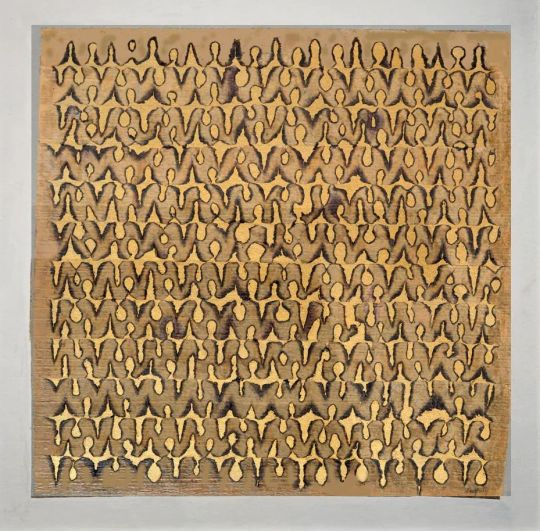
Pierre Daquin - 7. Ribambelle cuivrée, 2017. x
http://daquinpierre.com
63 notes
·
View notes
Text
La galerie Lazarew présente Inteface, l'exposition de Pierre Daquin
La galerie Lazarew présente Inteface, l’exposition de Pierre Daquin
Pierre Daquin, habitué des collections publiques prestigieuses du Musée d’art moderne de Paris ou du musée nous présente l’une de ses très rares expositions à la Galerie Lazarew jusqu’au 16 juin.
Un jeu de matière
Pierre Daquin est un peintre et lissier de formation née en 1936 à Paris. Il se fut une renommée avec ses tapisseries blanches épurées et en relief, évoquant les silences en ombres et…
View On WordPress
0 notes
Photo

Pierre Daquin - Interface #12 - Effilé au bleu, 2016. Papier kraft bitumé renforcé d’aluminium, arrachements, peinture / 60 x 60 cm. x
17 notes
·
View notes
Photo
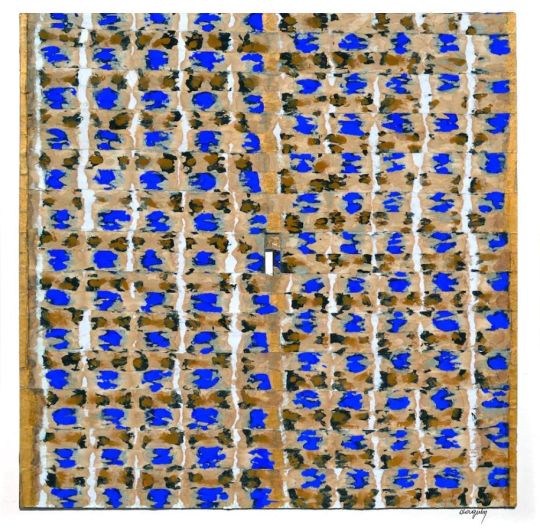
Pierre Daquin - Potomage papier n°15, 2017. Paper, weaving, paint, liquid copper / 55 x 55cm. x
12 notes
·
View notes
Photo
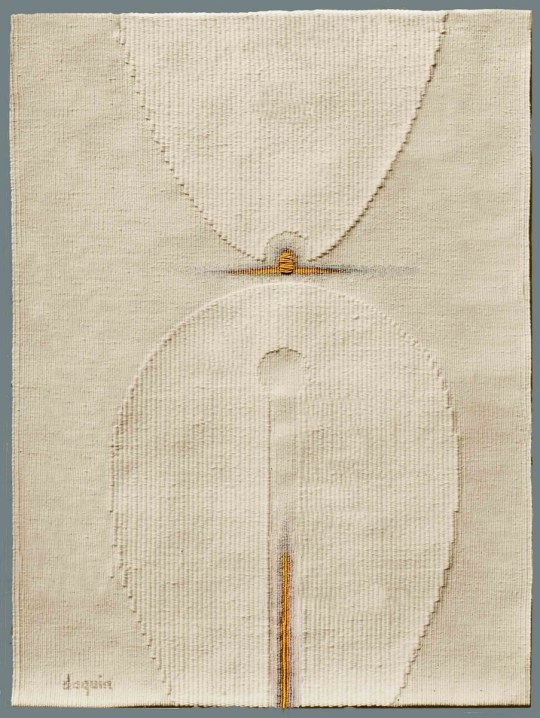
http://daquinpierre.com/tapisseries-de-pierre-daquin/
Pierre Daquin - Rémanence
58 notes
·
View notes
Photo

Pierre Daquin - Interface #24 - Déchiré diagonal, 2014. Kraft paper with asphalt, painting, tearing /50 x 50 cm. x
http://daquinpierre.com/
31 notes
·
View notes

